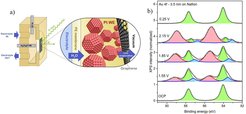In operando XPS and XAS on oxygen evolution reaction catalysts in confined liquid electrolyte
Rik Mom, Lorenz Frevel, Juan Velasco-Velez, Travis Jones, Detre Teschner, Katarzyna Skorupska, Axel Knop-Gericke, Robert Schlögl
To probe active electrocatalyst surfaces in a liquid environment, we have developed an XPS/XAS cell in which the catalyst is confined between a proton exchange membrane and graphene. While the proton exchange membrane supplies a steady flow of electrolyte to the electrode, the X-ray and electron-transparent graphene layer greatly reduces the evaporation of water into the NAP-XPS chamber. Using O K-edge spectra, we confirmed that this can lead to the formation of a thin layer of liquid electrolyte between the graphene and the membrane. Thus, electrocatalysts can be studied under operating conditions using surface sensitive soft Xray XPS and XAS [1,2].

With this methodology, we have studied the potential-driven restructuring of Ru, Pt and Au oxides in 0.1 M H2SO4 during the oxygen evolution reaction. Using Ru 3d/M-edge, Pt 4f and Au 4f spectra, we identified the distribution of cationic oxidation states as a function of potential (e.g. Figure 1b). For Au oxide, which is strongly covalent, only Au3+ is found, whereas the more oxophyllic Pt displays a gradual transition from Pt0 to Ptδ+/Pt2+/Pt4+ and further to Pt4+ [2]. For the yet more oxophyllic RuOx, we find a gradual oxidation to primarily Ru4+ under OER conditions, with some minor contributions of higher oxidation states. O K-edge spectra, complemented by theory, indicate that the final stages of oxidation of the catalysts occur through deprotonation, even in the bulk of the materials. The deprotonation proceeds through multiple stages: hydroxyl groups with higher coordination deprotonate at lower potential. Interestingly, we find that deprotonation is not complete during the oxygen evolution reaction on Ru oxide, in contrast to ab initio thermodynamics predictions [3]. Several studies have identified that the degree of crystallinity of OER electrodes influence their activity and stability [4]. Our in situ studies suggest that the reactive (deprotonated) oxygen species that dominate the surface of amorphous and crystalline Ru oxides under OER conditions are similar in nature. Rather, we explain the correlation between crystallinity and activity/stability by the larger amount of reactive species on amorphous electrodes.
[1] Frevel et al., J. Phys. Chem. C, 2019, 123 (14), 9146-9152
[2] Mom et al., J. Am. Chem. Soc., 2019, 141 (16), 6537–6544
[3] Fang et al., J. Am. Chem. Soc., 2010, 132, 18214-18222
[4] Paoli et al., Chem. Sci., 2015, 6, 190-196
